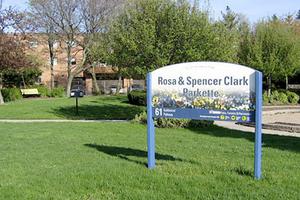This article is from our Toronto Feature series. Features from past programs are not updated.
This content is from a series created in partnership with Museum Services of the City of Toronto and Heritage Toronto. We gratefully acknowledge funding from the Ontario Ministry of Tourism, Culture and Sport, and the Department of Canadian Heritage.
Toronto Feature: Guildwood Village
Clarks Create Idyllic Community
In 1957, Rosa and Spencer Clark realized their dream of creating an ideal, modern residential community. They had founded the Guild of All Arts and the Guild Inn in Scarborough on 202 hectares of their rural land. Spencer oversaw the development of Guildwood Village, an idyllic garden community for 7000 residents, with schools, churches, community centres and shops.
The Clarks hired Dr. E.G. Faludi, a renowned Canadian urban planner, to create the master plan, which introduced new ideas in subdivision design. Winding roads discouraged speeding, buried utilities replaced overhead lines to maintain esthetics and mature trees were preserved wherever possible. At the grand entrance to the Guildwood Parkway they placed iron gates salvaged from the Stanley Barracks. The gates were forged in England in 1839, and still welcome residents and visitors today.
At the opening, the Avenue of Homes featured 12 model homes that were open to the public in what was called "the largest display of its kind anywhere in Canada." Some 25 000 visitors attended on the first weekend, leaving their cars parked in the fields that would soon be filled with homes.

 Share on Facebook
Share on Facebook Share on X
Share on X Share by Email
Share by Email Share on Google Classroom
Share on Google Classroom




